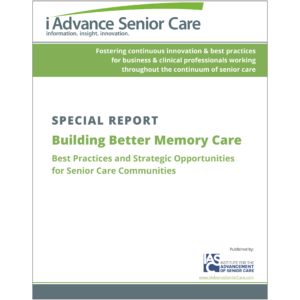Building a CCRC without walls
Hermann Weiss has never considered moving into a continuing care retirement community even though some might think he should at least entertain the idea at his stage in life.
Long-term care facilities are a foreign concept to the 75-year-old man, who is now retired from his post as a professor at the University of Michigan. Weiss grew up in Germany, where he watched his grandparents and father live out long lives at home until they passed away in their early nineties. His hope is to do the same here in America.
 So, while he never gave much thought to moving into a CCRC, it was actually a LTC community that he turned to in order to make his dream a reality. In 2010, Steve Hopkins of Evangelical Homes of Michigan visited the community where Weiss and his wife live and talked about the CCRC’s new LifeChoices program. The main goal of the program: To help seniors stay in their homes longer.
So, while he never gave much thought to moving into a CCRC, it was actually a LTC community that he turned to in order to make his dream a reality. In 2010, Steve Hopkins of Evangelical Homes of Michigan visited the community where Weiss and his wife live and talked about the CCRC’s new LifeChoices program. The main goal of the program: To help seniors stay in their homes longer.
LifeChoices had just been created and was a new concept for Ann Arbor-based Evangelical Homes, a 133-year-old CCRC which serves 2,300 older adults at its brick and mortar campuses throughout southeast Michigan. The product line was a bold step in an industry that has traditionally worked to bring people onto their campus, not to help keep them at home. The product offers an innovative option to the age-old in-home services business, and is currently only one of a dozen like it in the nation.
LifeChoices brings a variety of services typically offered at a CCRC to an individual’s home, and helping them stay there, secure in the knowledge that help is just around the corner as their needs change over the years. This subsidiary and service line allows Evangelical Homes to reach older adults before their health and wellness needs start to decline, allowing them to provide healthcare in a proactive manner that eventually leads to lower healthcare costs and less hospitalizations.
The idea was extremely appealing to Weiss, who is remarkably healthy and active for his age. He invested in LifeChoices and immediately took advantage of some of its wellness programs. Today, he’s visited both by a physical trainer and a massage therapist, twice a month.
“I am physically fitter than I was four or five years ago,” says Weiss, who now spends three hours a day swimming at a nearby lake. “I hiked mountains in Oregon in August and could climb steep hills more quickly and with more agility than in the past. I am now a part of a network that supports me in my endeavors and as I get older I know I will be able to rely on their services even more.”
SERVING A NEW SENIOR
Evangelical Homes President and Chief Executive Officer Denise Rabidoux would say Weiss is the reason her community took the leap into in-home services two years ago. LifeChoices was the answer to a question Rabidoux posed to the community’s board of directors when she first took the helm in 1999.
“I asked the board of directors to go on a journey with me to learn about the future of older adult needs and desires and to gain their support to really start to focus not just on the seniors we are caring for, but the group of older adults who would never drive onto our campus or live in our buildings,” Rabidoux says.
Rabidoux’s request of her board was a valid one. At the time, statistics showed that up to 95 percent of older adults were living in their home and not in a congregate living environment. A good portion—or 90 percent—of those adults would live out their life without ever moving onto a CCRC campus. And their own experience told them that the average person moving into their community was much older and frailer than in decades past.
A variety of factors were increasingly shaping the trend. A sharp jump in the older population—to 70 million from 30 million—played a significant role. A softer economy was another. A dip in investment values and flat home sale prices were forcing older adults to rethink their retirement plans and to sit tight where they lived. The average senior was unwilling to take a hit on their home just to move into a new community.
“Where in our organization’s strategic plan did we decide that we weren’t going to care for those older adults?” Rabidoux says.
The conversation led to an intense and strategic market study, which began with generic numbers and eventually led to intimate discussions with older adults sitting around living room fireplaces and in church fellowship halls. Evangelical Homes first asked seniors if their first choice was to live at home, and when they answered with a resounding, “Yes,” they asked what they would need to make that happen.
Older adults wanted security, wellness, healthcare services and environmental assistance in their home. They wanted access to the evolving benefits of a CCRC without having to go on campus to get it. Evangelical Homes knew it was time to expand, but this time, without adding another building.
BUILDING A CCRC WITHOUT WALLS
The catalyst for Evangelical Home’s entrance into the in-home services market was its purchase of two companies: one which was currently offering private duty services, such as personal care and support, and another that conducted Medicare in-home healthcare services. The purchases allowed Evangelical Homes to quickly gather knowledge and information on the market and create a foundation from which the other aspects of LifeChoices grew.
“Offering in-home services is definitely a different world than going up on the third floor of an apartment building that your organization owns,” says Steve Hopkins, vice president of wellness and home-based solutions at Evangelical Homes.
LifeChoices was created to be a CCRC without walls that provides older adults access to Evangelical’s entire continuum of care. Two years after its creation, LifeChoices offers a breadth of services including cooked meals, physical therapist consults, technology assistance, yard work, medication management and assistance with intricate healthcare needs. The services a member uses changes as their needs change, but the financial commitment doesn’t.
Individuals who join LifeChoices when they are healthy pay a one-time entrance fee around $40,000 to $50,000 and then a monthly fee of $400. From day one, members receive access to a brand and a program that will provide them with the full continuum of care that they will need the rest of their lives. There are 400 individuals served by up to 200 employees through Evangelical Homes’ home-based service programs including Medicare-certified, private duty, LifeChoices and LifeChoices Solutions subsidiaries.
“One of the drivers for people is that this is a fantastic way to put an exposure cap on the unknown of care for the rest of their lives,” Hopkins says. “The big dilemma for seniors is how they will pay for care for the rest of their lives.”
GRABBING MARKET SHARE, EXPANDING A MISSION
It may be counterintuitive for CCRCs to expand to in-home services, but some in the industry say it is a brilliant move with little to no disadvantages. Rick Morey, president of HomeTrak, a scheduling and management software platform for the private-duty homecare industry, says the in-home services sector is an opportunity for CCRCs to expand market share and recoup losses experienced on campus.
In 1994, Morey was an administrator at a senior living community in Sun City, Calif., and decided to create an in-home services brand when he realized that only three to four percent of income-qualified individuals were actually moving into his community. The idea was a success and by 2000 had grown into a $6 million business.
Morey’s move in the mid-1990s was bold. At that time, in-home services were seen as a competitor to a CCRC’s marketing efforts. It seemed impossible for CCRC marketing teams to blend their efforts to attract people onto their campuses with one aimed at keeping people in their homes. But Morey says the tide is changing. Today, Morey’s business services the in-home industry and he’s watched as more CCRCs are stepping outside their walls and into the community little by little.
The advantages of CCRCs offering in-home services are boundless, Morey states. An in-home services arm allows LTC communities to generate a fresh revenue stream and develop a new pipeline which connects seniors to their facilities. It also offers economies of scale when it comes to marketing efforts and referrals. Perhaps most importantly, it enables a CCRC to further tap into the ever burgeoning direct-care market which, according to the Paraprofessional Healthcare Institute (PHI), is expected by 2020 to be the nation’s largest workforce at five million workers.
Still, Evangelical Homes says its decision to offer LifeChoices was not driven by competition or a desire to reach seniors early in hopes of filling beds later. LifeChoices is more about furthering the community’s mission than increasing its market share, Rabidoux says.
"Our organization was built to serve older adults no matter where they call home,” she says. “It is part of our mission to serve older adults, period. And we realize that we can move faster toward that mission by bringing the services to them.”
Julie Thompson is a freelance writer based in Dayton, Ohio.
I Advance Senior Care is the industry-leading source for practical, in-depth, business-building, and resident care information for owners, executives, administrators, and directors of nursing at assisted living communities, skilled nursing facilities, post-acute facilities, and continuing care retirement communities. The I Advance Senior Care editorial team and industry experts provide market analysis, strategic direction, policy commentary, clinical best-practices, business management, and technology breakthroughs.
I Advance Senior Care is part of the Institute for the Advancement of Senior Care and published by Plain-English Health Care.
Related Articles
Topics: Articles , Facility management











